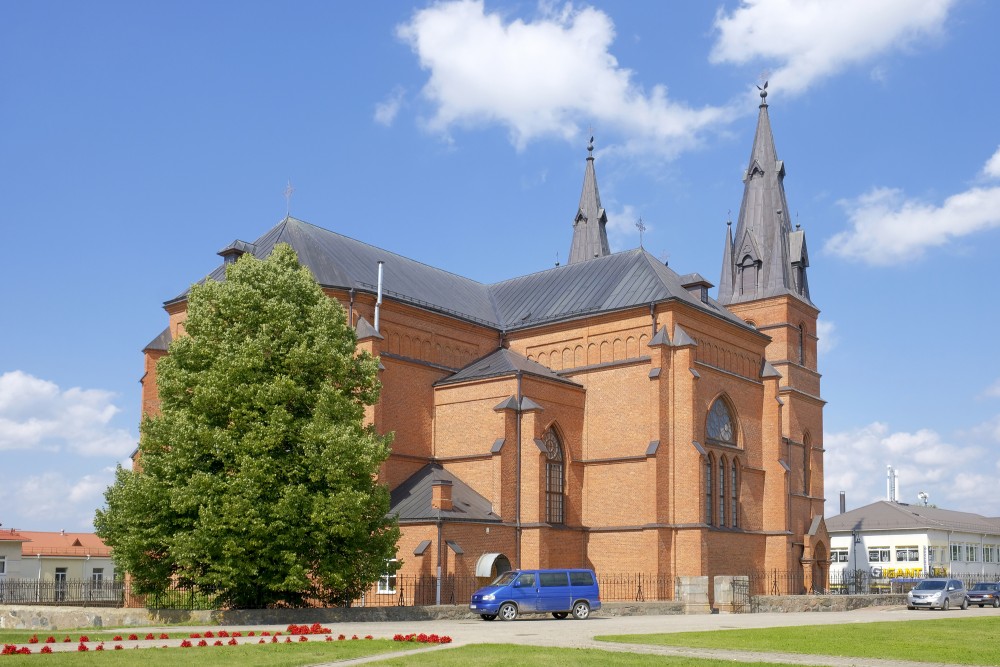Latvia’s historic churches reflect centuries of cultural depth and religious heritage. Each church tells a unique story. Visitors find both spiritual peace and architectural beauty within these sacred sites. The mix of Gothic, Baroque, and Romanesque styles captures every traveler’s attention. Not only do these churches serve as places of worship, but also as artistic landmarks. Many are well-preserved, despite the turmoil of war and time. Walk inside, and the silence speaks louder than words. Truly, Latvia’s historic churches offer more than just religious experiences.
A Rich Spiritual Legacy Behind Latvia’s Historic Churches
Latvia’s religious roots date back over 800 years to the Christianization of the Baltic region. German crusaders built the earliest churches in stone. Over time, Lutheranism became dominant, especially in rural Latvia. However, Catholicism remained strong in eastern regions like Latgale. Today, Latvia’s historic churches serve diverse denominations. Still, all these churches share deep cultural importance. They mark baptisms, weddings, and national holidays. Their bells once united entire villages in prayer. This spiritual legacy makes every visit deeply meaningful.
Key Highlights:
-
Latvia’s religious history spans over eight centuries.
-
Early churches were built by German crusaders.
-
Lutheran and Catholic churches coexist across the country.
-
Church bells held social and spiritual significance.
-
Churches often serve as local community centers.
Riga Cathedral: The Jewel of Latvia’s Historic Churches
Riga Cathedral, also known as the Dome Cathedral, stands as Latvia’s largest and oldest medieval church. Built in 1211, it dominates the skyline of Old Riga. The cathedral showcases Romanesque, Gothic, and Baroque elements. Its pipe organ, installed in 1884, still amazes music lovers worldwide. The church also hosts classical concerts and cultural events. Beyond its architecture, it tells the story of Riga’s Christian growth. Tourists and pilgrims visit year-round to admire its sacred grandeur. Indeed, Riga Cathedral symbolizes Latvia’s historic churches at their finest.
Interesting Features:
-
Built in 1211, it’s one of the oldest churches in the Baltics.
-
Includes a world-famous organ with over 6,700 pipes.
-
Hosts regular classical music performances.
-
Blends Romanesque, Gothic, and Baroque styles.
-
Centrally located in Old Riga’s historic district.
The Orthodox Splendor of the Nativity Cathedral in Riga
Not all of Latvia’s historic churches follow Western traditions. The Nativity of Christ Orthodox Cathedral offers Eastern charm. Built in the 19th century during Russian rule, it glows with golden domes. Inside, murals, icons, and candles transport visitors to another world. Despite Soviet-era closures, the church survived and flourishes today. Now fully restored, it welcomes worshippers and curious travelers alike. Its architecture blends Neo-Byzantine influences and Russian grandeur. Located in the heart of Riga, it remains a beacon of faith. Visitors leave with awe and respect for Orthodox traditions.
Why Visit This Cathedral:
-
Showcases Neo-Byzantine and Russian Orthodox design.
-
Features stunning gold domes and sacred icons.
-
Central location near Riga’s Esplanade Park.
-
Active church with services and liturgies.
-
Survived Soviet occupation and was fully restored.
Rundāle Palace Chapel: A Hidden Gem Among Latvia’s Historic Churches
Though part of a palace, the Rundāle Chapel deserves special attention. Located inside Rundāle Palace, it’s a perfect example of Baroque church art. Designed by Bartolomeo Rastrelli, the chapel features stucco, frescoes, and gold detailing. Unlike urban churches, this one nestles in rural Zemgale. Visitors often miss it while touring the palace itself. However, its beauty and serenity leave lasting impressions. The chapel served nobility but welcomed all in need of prayer. It’s both a historical and spiritual treasure. Never overlook this hidden marvel of Latvia’s historic churches.
Quick Facts:
-
Designed by the same architect as St. Petersburg’s Winter Palace.
-
Located in Latvia’s countryside, not a city center.
-
Part of the 18th-century Rundāle Palace complex.
-
Decorated with frescoes and golden accents.
-
Accessible to the public during palace tours.
Aglona Basilica: Latvia’s Sacred Pilgrimage Destination
Each year, thousands of pilgrims journey to Aglona Basilica in eastern Latvia. Located in Latgale, this Catholic church dates to 1768. Its white twin towers shine above the surrounding landscape. The basilica honors the Assumption of Mary, attracting believers every August 15. Pope John Paul II even visited in 1993. Inside, an ancient icon of Our Lady of Aglona draws the faithful. Miracles are said to happen here, inspiring continued devotion. The basilica’s grounds include sacred springs and quiet paths. Truly, Aglona stands as a spiritual heart of Latvia’s historic churches.
Highlights of Aglona Basilica:
-
Major Catholic pilgrimage site in Eastern Europe.
-
Home to the sacred icon of Our Lady of Aglona.
-
Hosts over 100,000 pilgrims annually on August 15.
-
Visited by Pope John Paul II in 1993.
-
Peaceful grounds with springs and chapels.
St. John’s Church in Cēsis: Medieval Beauty in a Fairytale Town
Cēsis, a charming town in central Latvia, houses one of the oldest churches in the country. St. John’s Church was built in the 13th century by German knights. Its red brick Gothic architecture still amazes visitors today. The church once served the Livonian Order, a powerful medieval force. Climb its tower for sweeping views of old Cēsis. Inside, vaulted ceilings and stone arches preserve its medieval charm. The church also hosts art exhibitions and concerts. For travelers exploring history, this church is a must-see. Cēsis and its church form an unforgettable pair.
Don’t Miss:
-
One of the oldest medieval churches in Latvia.
-
Climb the tower for panoramic views of Cēsis.
-
Gothic design with impressive stone architecture.
-
Hosts seasonal music and art events.
-
Tied to the legacy of the Livonian Order.
Wooden Churches: Humble Yet Powerful Symbols of Latvian Faith
Not all of Latvia’s historic churches rise in stone. In the countryside, many are built from simple wood. These wooden churches often date back to the 18th and 19th centuries. Despite their size, they offer warmth and peace. Their architecture reflects local traditions and nature’s influence. You’ll find carved crosses, wooden altars, and peaceful cemeteries nearby. Local communities care for them with great love and pride. These churches highlight Latvia’s deep connection to land and faith. They remain humble, sacred spaces that echo with rural spirituality.
Features of Latvia’s Wooden Churches:
-
Made entirely from local timber without nails.
-
Decorated with folk art, carvings, and modest altar pieces.
-
Often surrounded by ancient cemeteries and gardens.
-
Built by local craftsmen and churchgoers.
-
Still used today for services and community events.
Preservation Efforts Keep Latvia’s Historic Churches Alive
Maintaining Latvia’s historic churches takes dedication and resources. Harsh winters and age damage their structures over time. However, locals, churches, and government agencies unite to protect them. Many churches receive EU funding for careful restoration. Volunteers also contribute their time and skills. Preservation keeps heritage alive for future generations. These efforts also boost tourism and local pride. Through ongoing work, the spirit and beauty of each church remain strong. Thanks to these efforts, Latvia’s historic churches will inspire for centuries to come.
Preservation Strategies:
-
EU-funded restoration programs for historic buildings.
-
Community volunteer projects across rural regions.
-
Expert-led restoration of stonework, wood, and stained glass.
-
Educational programs about architectural history.
-
Support from churches, municipalities, and private donors.
Daugavpils Martin Luther Cathedral: A Lutheran Landmark in Latvia’s Historic Churches
In Daugavpils, Latvia’s second-largest city, the Martin Luther Cathedral stands as a key Lutheran landmark. Built in 1928, this red-brick church dominates the skyline of Church Hill. Its Neo-Gothic architecture, pointed arches, and tall spire reflect strong Northern European influences. The cathedral remains active, offering regular services and community events. Inside, visitors find a bright, spacious nave with beautiful stained-glass windows. As part of the diverse spiritual landscape, it plays a vital role in Latgale’s faith identity. Surrounded by other churches of different denominations, it represents religious coexistence. The cathedral also contributes to the growing appeal of Latvia’s historic churches.
Highlights of Martin Luther Cathedral:
-
Located on Church Hill, near multiple other churches.
-
Built in 1928 in Neo-Gothic style.
-
Serves as Daugavpils’ main Lutheran church.
-
Features a tall spire and red-brick exterior.
-
Active in community life and spiritual gatherings.
Roman Catholic Cathedral in Rēzekne: Sacred Heart of Catholic Faith in Latgale
The Sacred Heart of Jesus Cathedral in Rēzekne is a prominent symbol of Catholic faith in eastern Latvia. Built in 1904, this striking church blends Neo-Romanesque and Gothic Revival design elements. Twin towers and a rose window make the façade unforgettable. Inside, the marble altar and ornate decorations inspire reverence and awe. It serves as the central church for the Diocese of Rēzekne-Aglona. Pilgrims often visit on their way to Aglona Basilica. The cathedral’s importance to Latgale’s Catholic heritage cannot be overstated. As one of Latvia’s historic churches, it continues to inspire faith and regional pride.
Why Visit the Rēzekne Cathedral:
-
Built in 1904 with Neo-Romanesque and Gothic elements.
-
Seat of the Roman Catholic Diocese of Rēzekne-Aglona.
-
Known for its twin towers and stained-glass windows.
-
Hosts major Catholic events in the Latgale region.
-
Integral to the history of Latvia’s Catholic population.
Fascinating Facts About Latvia’s Historic Churches
-
Riga Cathedral’s organ was once the largest in the world.
-
Aglona Basilica draws over 100,000 visitors every August.
-
Latvia has over 1,000 churches scattered across its regions.
-
The oldest church is St. Mary’s in Irlava, built in 1185.
-
Several churches still use bells cast in the 1600s.
-
Wooden churches in Latgale were built without nails.
-
During Soviet times, many churches became warehouses or museums.
-
Church towers in Latvia often doubled as watchtowers.
Latvia’s historic churches offer more than religious value—they provide art, history, and cultural insights. From ornate cathedrals to wooden chapels, each site holds spiritual power. Travelers seeking meaning, beauty, or heritage find it here. Whether in Riga, Cēsis, or rural villages, inspiration lies around every corner. The stories inside these churches connect past and present. Visiting them supports local communities and preserves tradition. So next time you’re in the Baltics, don’t miss these sacred gems. Discover the timeless beauty of Latvia’s historic churches for yourself.

